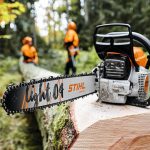Welcome to our comprehensive guide on chainsaw chain replacement. Whether you're a professional arborist or a DIY enthusiast, knowing when and how often to replace your chainsaw chain is crucial for maintaining optimal performance and safety. In this article, we will delve into the factors that determine chain lifespan, signs of wear and tear, and provide practical tips for extending the life of your chainsaw chain.
- Understanding Chainsaw Chain Lifespan:
The lifespan of a chainsaw chain depends on several factors, including usage frequency, cutting conditions, maintenance practices, and the quality of the chain itself. While there is no fixed timeframe for replacement, it is essential to monitor the chain's condition regularly. - Signs of Wear and Tear:
To determine if your chainsaw chain needs replacement, keep an eye out for the following signs of wear and tear:
- Dull cutting performance: If the chain struggles to cut through wood efficiently or leaves rough, uneven cuts, it may be time for a replacement.
- Excessive vibration: A worn-out chain can cause increased vibration, leading to fatigue and discomfort during operation.
- Chain derailment: If the chain frequently jumps off the guide bar or fails to stay in place, it may indicate a worn or damaged chain.
- Damaged or missing cutting teeth: Broken or missing cutting teeth significantly impact cutting performance and should be addressed promptly.
- Factors Affecting Chain Lifespan:
a. Usage Frequency: The more frequently you use your chainsaw, the faster the chain will wear out. Heavy-duty tasks, such as felling large trees, will put more strain on the chain and require more frequent replacements.
b. Cutting Conditions: Chainsaw chains endure harsh conditions, such as cutting dirty or frozen wood, which can accelerate wear. Additionally, cutting near the ground or hitting rocks can cause damage to the chain.
c. Maintenance Practices: Proper maintenance, including regular cleaning, lubrication, and tension adjustment, can significantly extend the lifespan of your chainsaw chain.
d. Chain Quality: Investing in a high-quality chain from reputable manufacturers will generally result in a longer lifespan and better overall performance. - Tips for Extending Chain Lifespan:
a. Sharpening: Regularly sharpening the chain's cutting teeth is crucial for maintaining optimal cutting performance and prolonging chain life.
b. Tension Adjustment: Keeping the chain properly tensioned ensures smooth operation and reduces the risk of derailment or premature wear.
c. Lubrication: Adequate lubrication reduces friction and heat buildup, preventing premature wear and prolonging chain life. Use high-quality bar and chain oil for best results.
d. Proper Cutting Techniques: Using the correct cutting techniques, such as avoiding excessive pressure and letting the chain do the work, can minimize strain on the chain and extend its lifespan.
Conclusion:
Knowing when to replace your chainsaw chain is essential for both performance and safety. By understanding the factors that affect chain lifespan, recognizing signs of wear and tear, and following proper maintenance practices, you can maximize the lifespan of your chainsaw chain and ensure efficient and safe cutting operations. Remember, a well-maintained chain not only improves cutting performance but also reduces the risk of accidents and costly repairs. Stay proactive and keep your chainsaw chain in top shape for optimal results.



Average Rating